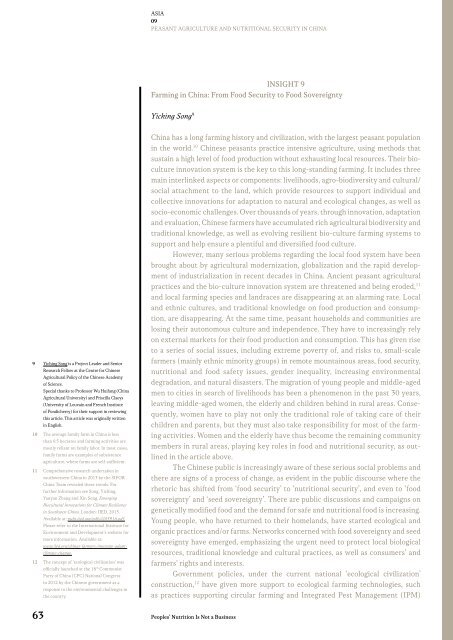RIGHT TO FOOD AND NUTRITION WATCH
1iNBHTY
1iNBHTY
You also want an ePaper? Increase the reach of your titles
YUMPU automatically turns print PDFs into web optimized ePapers that Google loves.
ASIA<br />
09<br />
PEASANT AGRICULTURE <strong>AND</strong> <strong>NUTRITION</strong>AL SECURITY IN CHINA<br />
INSIGHT 9<br />
Farming in China: From Food Security to Food Sovereignty<br />
Yiching Song 9<br />
9 Yiching Song is a Project Leader and Senior<br />
Research Fellow at the Centre for Chinese<br />
Agricultural Policy of the Chinese Academy<br />
of Science.<br />
Special thanks to Professor Wu Huifang (China<br />
Agricultural University) and Priscilla Claeys<br />
(University of Louvain and French Institute<br />
of Pondicherry) for their support in reviewing<br />
this article. This article was originally written<br />
in English.<br />
10 The average family farm in China is less<br />
than 0.5 hectares and farming activities are<br />
mostly reliant on family labor. In most cases,<br />
family farms are examples of subsistence<br />
agriculture, where farms are self-sufficient.<br />
11 Comprehensive research undertaken in<br />
southwestern China in 2013 by the SIFOR<br />
China Team revealed these trends. For<br />
further information see Song, Yiching,<br />
Yanyan Zhang and Xin Song. Emerging<br />
Biocultural Innovations for Climate Resilience<br />
in Southwest China. London: IIED, 2015.<br />
Available at: pubs.iied.org/pdfs/G03916.pdf.<br />
Please refer to the International Institute for<br />
Environment and Development’s website for<br />
more information. Available at:<br />
www.iied.org/chinas-farmers-innovate-adaptclimate-change.<br />
12 The concept of ‘ecological civilization’ was<br />
officially launched at the 18 th Communist<br />
Party of China (CPC) National Congress<br />
in 2012 by the Chinese government as a<br />
response to the environmental challenges in<br />
the country.<br />
63<br />
China has a long farming history and civilization, with the largest peasant population<br />
in the world. 10 Chinese peasants practice intensive agriculture, using methods that<br />
sustain a high level of food production without exhausting local resources. Their bioculture<br />
innovation system is the key to this long-standing farming. It includes three<br />
main interlinked aspects or components: livelihoods, agro-biodiversity and cultural/<br />
social attachment to the land, which provide resources to support individual and<br />
collective innovations for adaptation to natural and ecological changes, as well as<br />
socio-economic challenges. Over thousands of years, through innovation, adaptation<br />
and evaluation, Chinese farmers have accumulated rich agricultural biodiversity and<br />
traditional knowledge, as well as evolving resilient bio-culture farming systems to<br />
support and help ensure a plentiful and diversified food culture.<br />
However, many serious problems regarding the local food system have been<br />
brought about by agricultural modernization, globalization and the rapid development<br />
of industrialization in recent decades in China. Ancient peasant agricultural<br />
practices and the bio-culture innovation system are threatened and being eroded, 11<br />
and local farming species and landraces are disappearing at an alarming rate. Local<br />
and ethnic cultures, and traditional knowledge on food production and consumption,<br />
are disappearing. At the same time, peasant households and communities are<br />
losing their autonomous culture and independence. They have to increasingly rely<br />
on external markets for their food production and consumption. This has given rise<br />
to a series of social issues, including extreme poverty of, and risks to, small-scale<br />
farmers (mainly ethnic minority groups) in remote mountainous areas, food security,<br />
nutritional and food safety issues, gender inequality, increasing environmental<br />
degradation, and natural disasters. The migration of young people and middle-aged<br />
men to cities in search of livelihoods has been a phenomenon in the past 30 years,<br />
leaving middle-aged women, the elderly and children behind in rural areas. Consequently,<br />
women have to play not only the traditional role of taking care of their<br />
children and parents, but they must also take responsibility for most of the farming<br />
activities. Women and the elderly have thus become the remaining community<br />
members in rural areas, playing key roles in food and nutritional security, as outlined<br />
in the article above.<br />
The Chinese public is increasingly aware of these serious social problems and<br />
there are signs of a process of change, as evident in the public discourse where the<br />
rhetoric has shifted from ‘food security’ to ‘nutritional security’, and even to ‘food<br />
sovereignty’ and ‘seed sovereignty’. There are public discussions and campaigns on<br />
genetically modified food and the demand for safe and nutritional food is increasing.<br />
Young people, who have returned to their homelands, have started ecological and<br />
organic practices and/or farms. Networks concerned with food sovereignty and seed<br />
sovereignty have emerged, emphasizing the urgent need to protect local biological<br />
resources, traditional knowledge and cultural practices, as well as consumers’ and<br />
farmers’ rights and interests.<br />
Government policies, under the current national ‘ecological civilization’<br />
construction, 12 have given more support to ecological farming technologies, such<br />
as practices supporting circular farming and Integrated Pest Management (IPM)<br />
Peoples’ Nutrition Is Not a Business


